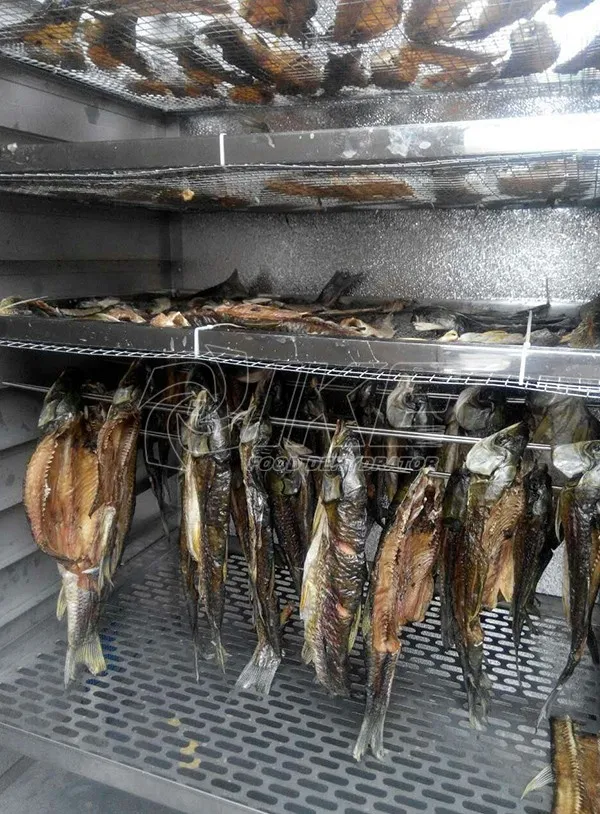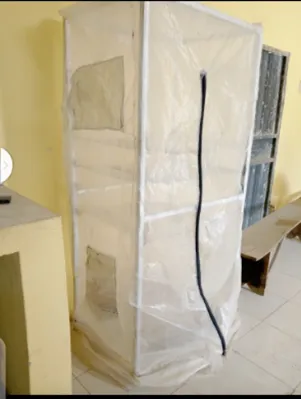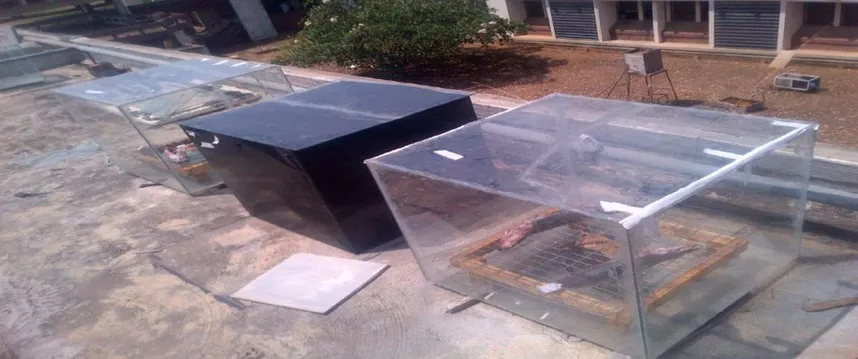INTRODUCTION

Source
The primary aim of fish drying is to prolong the shelf-life of fish by removing as much moisture as possible from fish flesh so that the resultant product is rendered unsuitable for microbial decay, insect infestation and other forms of deterioration before drying. Sun-drying is a common practice among fisher folks in the arid and semi-arid regions of Nigeria. This practice is faced with a lot of problems such as partial removal of moisture from the fish leading to bacterial decay, contamination by dust and insect infestation. To reduce post-harvest losses and to improve the poor conditions of fish dried on bare ground, the NIFFR Solar Tent Dryer was developed and widely extended it is accepted in many fishing villages around the Kainji and Jebba Lakes. Fishes dried in NIFFR Solar Tent dryer are cleaner and better than those on bare ground, which is the traditional practice. Initially, a wooden solar tent dryer was first constructed to sundry fish species but as time went on, it was later modified using iron in its construction considering the durability of both tent dryers.
The Metal-constructed NIFFR Solar Tent Dryer
The metal constructed solar tent dryer, like every other solar tent dryer, works with principle of greenhouse effect. The only difference between this solar tent dryer and every other solar tent dryer is that it is constructed with iron, to make it firmer and to make it last. This solar powered dryer, can be used to dry non-fatty fishes like Bagrus bayad, Clupeids (Pellonula afzelliusi) and majorly stock-fishes. More so, the solar tent dryer, can also be used to dry other species of fishes like catfishes however, the fishes will have to be cut into junks for faster drying. This process takes about 24 – 48 hours to sundry the fish with sufficient sunlight and with sizeable fishes.
A research carried out at NIFFR and still ongoing, shows that, the solar tent cannot only be used for non-fatty fishes, but can be used for fatty fishes like Clarias gariepinus. This can only be achieved when the solar tent dryer is well constructed with the right materials and if the fish is well split.
Design and Construction Procedure
The dryer (WAAPP DESIGNED) is made up of dismountable 2.5 hollow pipes. It is rectangular in shape with the vertical height being longest.
It is constructed by fastening the iron pipes together in a rectangular shape. The dryer also has up to 3 removable drying racks suspended on an iron flap fitted to the structure to accommodate more fish.
The tent dryer is worn a polyethylene sheet (transparent nylon) with the purpose of heat emission in the tent. The transparent nylon has spaces at the sides, which is covered with a netting material to allow a free passage of air in and out of the tent.
The transparent polyethylene cover is also fitted with a zip for access.
Mode of Operation
The NIFFR Solar Tent Dryer (modified) operates using the greenhouse principle of trapping and storing solar energy from the sun for drying fish and other household items.

The transparent polythene is the greenhouse media while the black stones underneath; act like solar energy absorbers. The polyethylene is transparent to incoming solar radiation but opaque to outgoing terrestrial radiation.
Advantages of the modified NIFFR solar tent dryer in fish processing
It allows easy drying of large fish and could therefore partly replace fish smoking and consequently help to save firewood.
It increases the income of fishermen because of the excellent quality of the product that attracts higher market prices.
The tent operates on almost no running cost.
Solar Tent drying practice is healthier than fish smoking that exposes the processed fish to carcinogenic particles, from smoke.
Its easy operation does not need supervision during the processing procedure.
It makes use of a renewable source of energy. The solar tent dryer uses solar energy to mitigate the problem of deforestation so as to conserve forest resources.
It is cheap and easy to afford or construct.
It is efficient and produces better dried fishes than the open sun drying methods of fish processing.
CONCLUSION
Local methods of drying fish (sun drying) have many limitations, such as includes, long period of drying during cloudy weather. Fish dried by sun often results in low quality as a result of the slow process of drying, insect infestation and contamination from air borne dust etc. However, drying fish by solar tent fish dryers of which the NIFFR solar tent dryer is part enhances the production of hygienic, high quality, goodly dried fish and at a low cost.

